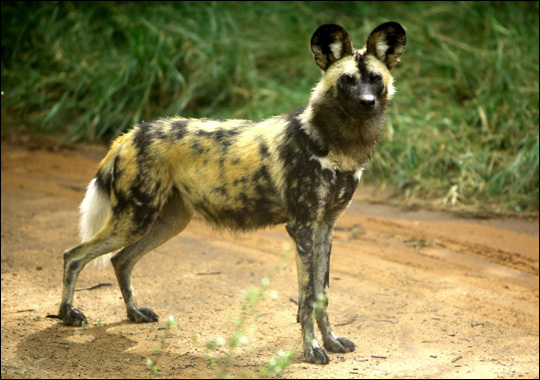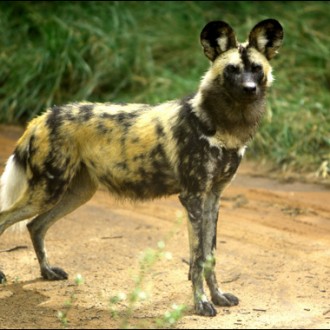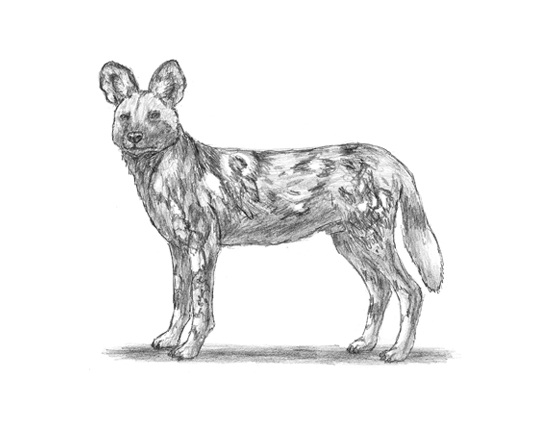


Please PAUSE the video after each step to draw at your own pace (scroll down to see the final African wild dog drawing).
How to Draw an African Wild Dog
For the first few steps, don’t press down too hard with your pencil. Use light, smooth strokes to begin.
Step 1: Draw two circles as guides for the African wild dog’s body. They don’t have to be perfect. They’re just guides. Pay attention to the space between the circles. If they’re too far apart, the African wild dog will be too long.
Step 2: Draw a smaller circle on the upper left side as a guide for the African wild dog’s head.
Step 3: Draw two intersecting lines inside the African wild dog’s head to help you place the facial features later on.
Step 4: Draw a small circle on the lower part of the African wild dog’s head as a guide for the muzzle.
Step 5: Draw two arcs on top of the African wild dog’s head as guides for the ears.
Step 6: Draw four lines under the body (two below each circle) as guides for the legs. African wild dogs have long legs, so the lines should be pretty long. Also angle the lines forward a bit.
Step 7: Draw a series of curved lines that connect the major shapes to form the body. Draw a small line on the right side as a guide for the African wild dog’s tail.
That’s it for the initial sketch! From this point on, press harder with your pencil to get a more defined sketch.
Step 8: Draw the eyes inside the African wild dog’s head using the lines as guides for placement. The shape of the eyes is similar to a half circle. Draw a small circle inside each eye and shade it in except for a small part to represent glare. Add a few lines on the outside as extra detail.
Step 9: Draw the African wild dog’s nose inside the muzzle. First lightly draw an oval. Then darken it, giving it more shape. Draw shaded circles on the sides for the nostrils.
Step 10: use the small circle as a guide to draw the rest of the muzzle under the nose. Using quick, short strokes, draw a furry line under the nose that extends up toward the left eye. Draw another furry line underneath for the African wild dog’s chin and lower jaw. Draw a few lines for whiskers on the top part.
Step 11: Use the arcs on the African wild dog’s head as guides to draw the ears. Darken the arcs and give them a more angular shape. Use quick, short strokes to represent the fur within them.
Step 12: Use the original circle as a guide to draw the rest of the African wild dog’s head. Use quick, short strokes to represent fur. The left side of the head should come inward a bit.
Step 13: Using the lines as guides, draw the African wild dog’s front legs. Draw lightly at first to get the shape of the leg right. The African wild dog is the second largest canid behind only the wolf, so the legs should be tall and lean. The base or top part of the leg should be thicker. The foot bends forward at the joint, and the bottom should be big for the paw. Darken it using quick, short strokes. Use the other line to draw the leg on the other side the same way. Draw a few curved lines within the paw to represent the toes.
Step 14: Use the other two lines as guides to draw the African wild dog’s hind legs the same way as the front legs. The hind legs are thicker at the base and angle back more. Draw lightly at first. When you’re happy with what you have, darken it using quick, short strokes. Don’t forget to draw the toes! Finish up the leg on the other side using the same technique.
Step 15: Darken the remaining lines using quick short strokes to draw the African wild dog’s body.
Step 16: Thicken up the initial line using quick, short strokes to draw a bushy tail.
Step 17 (optional): You can stop here for a sketchy look or erase as much as you can of the initial guide lines for a cleaner look. Don’t worry about erasing all of them. It’s okay to leave some behind. Also re-draw any final sketch lines that you may have accidentally erased.
Step 18 (optional): Add some shading to your African wild dog drawing to give it more dimension and volume. Pick the direction of the light source when shading so that the shadows are consistent with it. Vary the pressure on your pencil to get different degrees of tonal value.
Step 19 (optional): Add a cast shadow underneath. This helps ground the African wild dog so it doesn’t appear to be floating.
Step 20: Add more value throughout your drawing to create the recognizable African wild dog coat. The lower part of the head and the outer rim of the ears are usually darker. The pattern on the body is different on every African wild dog, so draw random patches and spots everywhere. Be creative! If you want more accuracy, it’s a good idea to use reference. PAUSE the video to use my drawing as a reference and any other time you need help.


